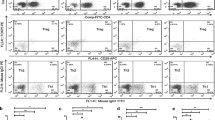Abstract
Background
Glucocorticoid receptors are expressed in white blood cells (WBC’s) and are known to play a role in cell adhesion and WBC’s recruitment from bone marrow. In Cushing’s disease leukocytosis is frequently mentioned as laboratory finding. However, there is no data on the prevalence of this finding among patients, or correlation with disease severity.
Purpose
To investigate the prevalence of leukocytosis in patients with Cushing’s disease, alterations in other blood count parameters and correlation with degree of hypercortisolism.
Methods
Data of 26 patients diagnosed and followed for Cushing’s disease at our clinic was reviewed. Two patients had disease relapse after complete remission and were studied as 2 separate events.
Results
Of the 26 patients, 17 were women (71 %), with a mean age of 39.8 ± 12.7 years. Mean baseline WBC count was 10,500 ± 2,600 cells/μl and dropped to 8,400 ± 1,900 cells/μl (p < 0.05) after treatment, mean neutrophil count at baseline was 7,600 ± 2,600 cells/μl and dropped to 5,300 ± 1,700 cells/μl (p < 0.05), lymphocyte count was 2,000 ± 600 cells/μl and raised to 2,300 ± 600 cells/μl (p < 0.05), hemoglobin was 13.7 ± 1.2 g/dl and dropped to 12.8 ± 1.4 g/dl (p < 0.05), and platelet number did not change. Elevated WBC count was present in 11/28 cases (40 %). Those patients with normal baseline WBC (mean 9,000 ± 1,500 cells/μl) dropped also to 7,700 ± 1,300 cells/μl after treatment (p < 0. 05). There was a significant positive correlation between decrease in UFC secretion and change in WBC’s following treatment (r = 0.67, p < 0.01).
Conclusions
Patients with Cushing’s disease present with leukocytosis in approximately 40 % of cases. In most cases, including those without elevated baseline count, the WBC’s decreased with disease remission, demonstrating the effect of glucocorticoids on these blood cells.



Similar content being viewed by others
References
Cushing HW (1932) The basophil adenomas of the pituitary body and their clinical manifestations. Bull Johns Hopkins Hosp 50:137–195
Newell-Price J, Trainer P, Besser M, Grossman A (1998) The diagnosis and differential diagnosis of Cushing’s syndrome and pseudo-Cushing’s states. Endocr Rev 19:647–672
Lindholm J, Juul S, Jørgensen JO, Astrup J, Bjerre P, Feldt-Rasmussen U, Hagen C, Jørgensen J, Kosteljanetz M, Kristensen L, Laurberg P, Schmidt K, Weeke J (2001) Incidence and lateprognosis of cushing’s syndrome: a population-based study. J Clin Endocrinol Metab 86:117–123
Pecori Giraldi F, Moro M, Cavagnini F (2003) Gender-related differences in the presentation and course of Cushing’s disease. J Clin Endocrinol Metab 88:1554–1558
Dela Balze FA, Reifenstein EC Jr, Albright F (1946) Differential blood counts in certain adrenal cortical disorders (Cushing’s syndrome, Addison’s disease and panhypopituitarism). J Clin Endocrinol Metab 6:312–319
Rhen T, Cidlowski JA (2005) Antiinflammatory action of glucocorticoids—new mechanisms for old drugs. N Engl J Med 353:1711–1723
Lionakis MS, Kontoyiannis DP (2003) Glucocorticoids and invasive fungal infections. Lancet 362:1828–1838
Dougherty TF, Abraham W (1944) Influence of hormones on lymphoid tissue structure and function. The role of the pituitary adrenotrophic hormone in the regulation of the lymphocytes and other cellular elements of the blood. Endocrinology 35:1–14
Nakagawa M, Terashima T, D’yachkova Y, Bondy GP, Hogg JC, van Eeden SF (1998) Glucocorticoid-induced granulocytosis: contribution of marrow release and demargination of intravascular granulocytes. Circulation 98:2307–2313
Cox G (1995) Glucocorticoid treatment inhibits apoptosis in human neutrophils. Separation of survival and activation outcomes. J Immunol 154:4719–4725
Dale DC, Fauci AS, Wolff SM (1974) Alternate-day prednisone. Leukocyte kinetics and susceptibility to infections. N Engl J Med 291:1154–1158
Mishler JM, Emerson PM (1977) Development of neutrophilia by serially increasing doses of dexamethasone. Br J Haematol 36:249–257
Grafte-Faure S, Leveque C, Vasse M, Soria C, Norris V, Vannier JP (1999) Effects of glucocorticoids and mineralocorticoids on proliferation and maturation of human peripheral blood stem cells. Am J Hematol 62:65–73
Shipman GF, Bloomfield CD, Gajl-Peczalska KJ, Munck AU, Smith KA (1983) Glucocorticoids and lymphocytes. III. Effects of glucocorticoid administration on lymphocyte glucocorticoid receptors. Blood 61:1086–1090
Brunetti M, Martelli N, Colasante A, Piantelli M, Musiani P, Aiello FB (1995) Spontaneous and glucocorticoid-induced apoptosis in human mature T lymphocytes. Blood 86:4199–4205
Deutsch V, Lerner-Geva L, Reches A, Boyko V, Limor R, Grisaru D (2007) Sustained leukocyte count during rising cortisol level. Acta Haematol 118:73–76
Sato T, Hiramatsu R, Iwaoka T, Fujii Y, Shimada T, Umeda T (1984) Changes of platelets, serum lactic dehydrogenase, gamma-glutamyltranspeptidase, choline esterase and creatine phosphokinase levels in patients with Cushing’s syndrome. Tohoku J Exp Med 142:195–200
Moraes LA, Paul-Clark MJ, Rickman A, Flower RJ, Goulding NJ, Perretti M (2005) Ligand-specific glucocorticoid receptor activation in human platelets. Blood 106:4167–4175
Bagby GC Jr, Goodnight SH, Mooney WM, Richert-Boe K (1979) Prednisone-responsive aplastic anemia: a mechanism of glucocorticoid action. Blood 54:322–333
Manenschijn L, van den Akker EL, Lamberts SW, van Rossum EF (2009) Clinical features associated with glucocorticoid receptor polymorphisms. An overview. Ann N Y Acad Sci 1179:179–198
Yang N, Ray DW, Matthews LC (2012) Current concepts in glucocorticoid resistance. Steroids 77:1041–1049
Conflict of interest
The authors declare that they have no conflict of interest.
Author information
Authors and Affiliations
Corresponding author
Rights and permissions
About this article
Cite this article
Masri-Iraqi, H., Robenshtok, E., Tzvetov, G. et al. Elevated white blood cell counts in Cushing’s disease: association with hypercortisolism. Pituitary 17, 436–440 (2014). https://doi.org/10.1007/s11102-013-0522-0
Published:
Issue Date:
DOI: https://doi.org/10.1007/s11102-013-0522-0




